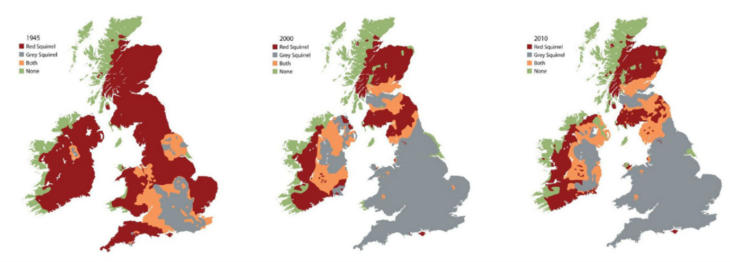Why save the red squirrel?
This week is both Red Squirrel Awareness Week and the week of Saving Scotland’s Red Squirrels’ Great Scottish Squirrel Survey! What better week to remind ourselves of why, as the lead partner in Saving Scotland’s Red Squirrels for almost 15 years, the Trust has been so dedicated to trying to prevent the extinction of our native squirrel?
By now, followers of the Trust’s work will be well-versed on the reasons for the red squirrel’s monumental decline in the British Isles – the interacting effects of habitat loss due to deforestation, and competition and disease transmission from the invasive non-native grey squirrel have led to the replacement of reds by greys across most of England and Wales and parts of Scotland and Northern Ireland.
But aside from its rarity in Britain, what is it that makes the red squirrel important enough for conservationists, against all adversity, to want to keep fighting its corner?

Maps showing the decline of red squirrels and rise of grey squirrels across the UK between 1945 and 2010 (Credit: Dr Craig Shuttleworth/ Red Squirrel Survival Trust)
Socio-economic significance
Well, the red squirrel is more to Scotland than just an incredibly cute and charismatic ball of fur. The species is one of the UK’s best loved mammals and it is well known that within the UK, Scotland is the place to come and see them. As one of Scotland’s ‘Big 5’ native animals, the possibility of spotting a red squirrel in the wild is a major tourism draw to the regions of Scotland that still have them, such as the Highlands, Dumfries and Galloway, Loch Lomond and the Trossachs National Park and Perthshire. In a NatureScot assessment of the economic impact of nature based tourism in Scotland, it was estimated that wildlife watching contributes approximately £138 million to the Scottish economy annually and creates 3,943 FTE jobs. It is likely that a sizeable chunk of this economic contribution can be attributed to the presence of the highly popular red squirrel.
Having charismatic mammals like the red squirrel living in our forests and woodlands can also contribute to societal health and wellbeing by sparking people’s interest in nature, inspiring them to spend more time outdoors and take better care of their environment.
Ecological significance
The red squirrel is the only squirrel species to have evolved with our native woodlands since the last ice age, and so is unique in Britain in terms of the ecological niche that it fills. Red squirrels are conifer specialists, but do best in mixed native woodland. They store tree seeds by burying them in the ground and many of these eventually germinate into new tree seedlings. As a fungivore, the species also spreads the spores of the mycorrhizal fungi that trees rely on for healthy growth and disease resistance. The red squirrel is therefore an important facilitator of native woodland regeneration and healthy maturation.
Grey squirrels also bury tree seeds and can help with woodland regeneration, but they also inflict damage on young trees through bark-stripping which, at high grey densities, will likely negate much of the benefit seen from seed dispersal. Red squirrels are also known to exhibit this behaviour, but grey squirrels can exist at much higher densities than reds, so the damage that they have the potential to cause to a woodland is much greater.
Despite the threats posed to it, Scotland still has a relatively large and genetically diverse red squirrel population. This makes it an important source for future reintroduction efforts to other parts of the country. The maintenance of this genetically healthy population will therefore be essential for the continued recovery of the species in the UK.
In a nutshell, the red squirrel is a beautiful and unique part of our native fauna. The species adds a vibrancy to our woodlands that inspires people to get out and experience nature. This in turn brings economic benefits through wildlife tourism, as well as societal health and wellbeing benefits. The red squirrel is the UK’s only native squirrel species and fills an important niche in our woodland ecosystems. It is imperative that conservation efforts to save this species continue so that future generations can enjoy their beauty and benefit from the diverse ecosystem services that they provide.
Further information:
Take part in this year’s Great Scottish Squirrel Survey
Author: Hazel Forrest, Species Advocacy Officer
hforrest@scottishwildlifetrust.org.uk
Help protect Scotland’s wildlife
Our work to save Scotland’s wildlife is made possible thanks to the generosity of our members and supporters.
Join today from just £3 a month to help protect the species you love.
Preface
This week is both Red Squirrel Awareness Week and the week of Saving Scotland’s Red Squirrels’ Great Scottish Squirrel Survey! What better week to remind ourselves of why, as the …
